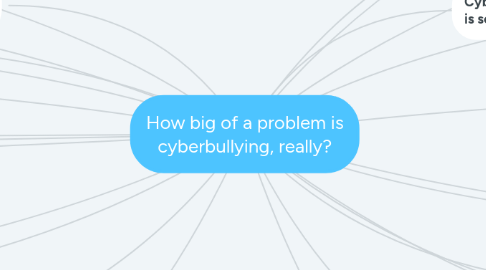How big of a problem is cyberbullying, really?
저자: Naydelyn Soto Villela

1. This qoute means that cyberbullying is more of problem than you think.
2. This qoute makes me think we need to come up a solution to solve this problem and stop cyberbulliers.
3. Cyberbullying among students is a dangerous epidemic.
4. The author of the article thinks that bullying and suicide have a connection ("Suicide risk greater with cyberbullying").
5. The core question is "whether young people are driven to suicide as a direct result of bullying, or as a result of underlying mental-health problems" ("Suicide risk greater with cyberbullying").
6. Statistics say that "cyberbullying may pose the greatest danger," when calculating suicide risk ("Suicide risk greater with cyberbullying").
7. According to police reports "more than half of cyber-stalkers know their victims personally,"(Doucet).
8. Doucet argues that "Cyber-bullying is a lot more common than might be expected"(Doucet).
9. Because the cyberbullies mentally abuse the victims.
10. This qoute makes me think that kids shouldnt get phones at such a young age and parents shouldnt just give there kids such a privilege like that.
11. This qoute shows me that i need to be more careful on who i become friends with and be more mindful on this situation.
12. Because profeshional people in the field have proven that cyberbullying could be the greatest danger towards kids who are vulnerable.
13. Doucet has concluded that cyberbullying is causing a serious problem and is increasingly damaging our society (Doucet).
14. Cyberbullying amongst students is serious but not an epidemic.
15. Magid argues that prarents should be more calm, and not overeact to cyberbullying (Magid).
16. The author asserts that youth who report being physically bullied "actually decreased between 2003 and 2008 from 22% to 15%" (Magid).
17. Statistics say that every one in five teens have been cyberbullied in one point in there life and is 10% in the past 30 days "one in five teens have been cyberbullied at least once in their lifetimes and 10% in the past 30 days, that's bad, but not an epidemic" (Magid).
18. Adam Carey wrote an article saying that communities are over exaggerating the problem of cyberbullying and its effects ("Cyber bullying fears").
19. The author cited stastistics saying that "a child is three times more likely to be bullied in the real world than online"("Cyber bullying fears").
20. Further statistics were reported saying that "10 per cent of students in years four to nine claimed to have been cyber-bullied at least once every few weeks, compared to 30 per cent who reported being bullied while not online" ("Cyber bullying fears").
21. Because bullying in real in real life is more likely to happen than online.
22. This qoute does make me think that cyberbullying is decreasing which is such a good thing but to decrease even more we have act on it more.
23. I think the author is not really thinking about how cyberbulying is an actual problem in our society, children at such a young age are driven towards suicide because of a person they do not know.
24. That may be true but it doesnt mean we pay less attention to the problem of cyberbullying and act on it less, cyberbullying is still a huge problem.
25. I think that cyberbullying is still a huge problem in our society meaning that we should keep acting on the problem even though it is still decreasing.
26. Because everyone does it so it must be okay and as well makes it seem normal.


